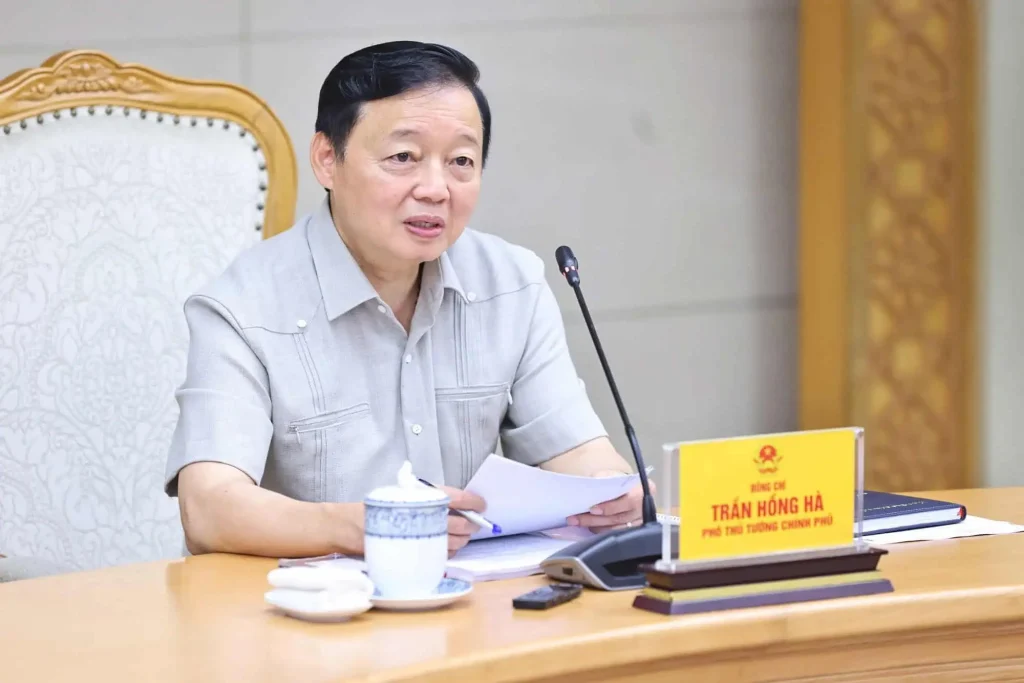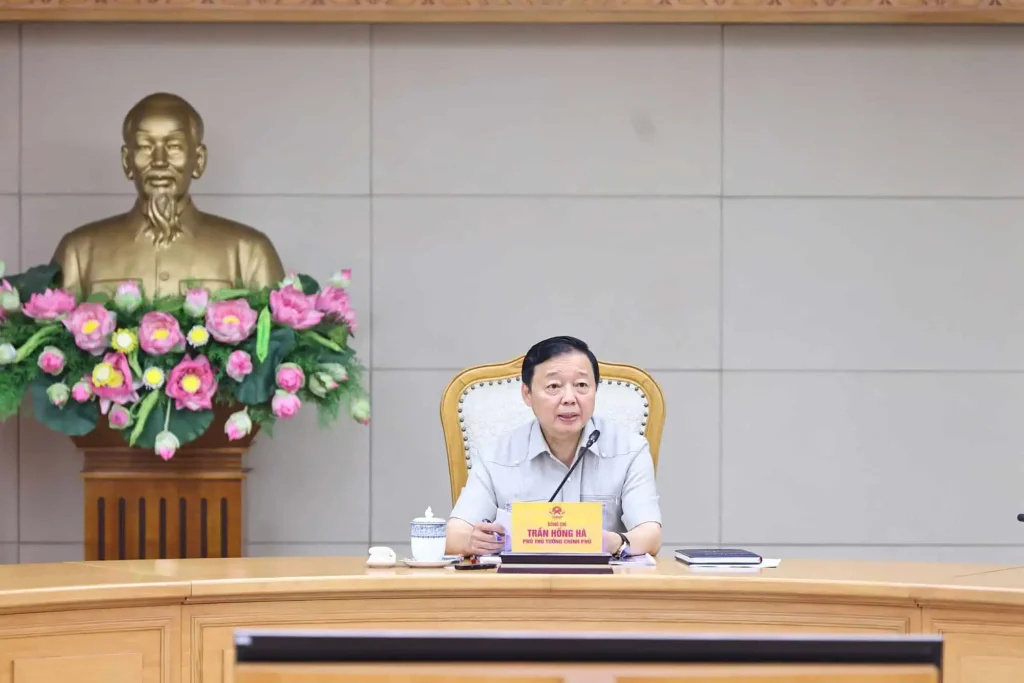Detailed planning of seaport groups to become 'fertile land' for large shipping lines
On the morning of August 28, Deputy Prime Minister Tran Hong Ha chaired a meeting with a number of ministries, branches and localities on the draft Detailed Planning of seaports, ports, wharves, buoys, water areas and water regions for the 2021-2030 period, with a vision to 2050 (Detailed Planning of Seaports); listening to a report on the investment policy of the Saigon Gateway International Transit Port Project.

Does not hamper creativity and efficiency
Deputy Minister of Transport Nguyen Xuan Sang said that the detailed planning of seaport groups aims to concretize the master plan of the seaport system, serving as a basis for formulating policies and solutions for seaport development to meet the needs of socio-economic development, ensuring national defense and security of localities, regions and the whole country.
The planning is detailed for each seaport, port area, determining the number of ports, wharves, and port types for the period up to 2030: a number of large-scale port areas and wharves are expected for the period 2030-2050 to serve the overall investment call (Nam Do Son, Con Ong-Hon Net, Lien Chieu, Can Gio, Cai Mep Ha, Cai Mep Ha downstream, Tran De).
In addition, the Plan also proposes contents related to the development of public maritime infrastructure; orientation of connecting traffic infrastructure; orientation of development of other wharves and ports as a basis for implementation in subsequent plans or as a basis for reporting to competent authorities for consideration, decision or approval in the step of approving the policy and preparing for investment. At the same time, it determines the need for land and water use; investment capital needs; list of priority investment tasks until 2030; solutions and implementation organization...
The plan sets out targets for cargo and passenger output and infrastructure for each group of seaports, seaports, and wharf areas (determining the number of ports and wharves) based on forecast results. Specifically, by 2030, the total volume of cargo and passengers passing through the seaport system will be 1,249-1,493 million tons (of which, container cargo will be 46.3-54.3 million TEUs); passengers will be 17,382-18,845 million...
General Director of Vietnam National Shipping Lines Nguyen Canh Tinh and Chairman of the Board of Directors of Saigon Port Joint Stock Company Huynh Van Cuong both said that the development and implementation of the Plan will actively contribute to promoting services related to container port exploitation; container loading and unloading services; customs clearance services; cargo transportation services; bridge, wharf and mooring buoy services... In developing the Plan, it is necessary to clearly define the objectives and specific contents regarding cargo targets and infrastructure for each group of seaports, seaports and wharf areas.

Concluding this content, Deputy Prime Minister Tran Hong Ha emphasized that the Planning must be synchronous, unified, based on scientific criteria, "dynamic, open" to adjust and update promptly on technology, management methods, changes in the region and internationally... At the same time, propose a number of mechanisms and policies to develop safe and convenient seaport infrastructure, effective investment for the world's leading shipping lines, with the overall management and operation of the State, promoting the capacity and creativity of investors.
The Ministry of Transport and planning consultants ensure complete documentation and procedures in accordance with the law on planning, maritime, and transportation; the accuracy and scientific nature of data, the basis for assessing and forecasting development scenarios; and consistency and synchronization with specialized, regional, and local planning.
The Deputy Prime Minister also requested the Ministry of Transport to regularly monitor and report unexpected changes, beyond forecasts, so that “planning does not constrain creativity and efficiency”. New contents added to the plan need to be evaluated for their objectives and overall effectiveness, especially the relationship and impact on large, strategic projects.

Thorough research and comprehensive assessment of the Saigon Gateway International Transit Port Project
Also at the meeting, the Ministry of Planning and Investment reported on the Saigon Gateway International Transit Port Project in Can Gio District (HCMC) providing services related to the exploitation of container ports and seaports; with an expected scale of 571 hectares; total investment capital of about 113.5 trillion VND; 7 investment phases within 22 years.
At the meeting, leaders of ministries, branches and Ho Chi Minh City discussed and analyzed the implementation progress, total investment capital, technical infrastructure, and traffic connection with the Project.
According to Mr. Nguyen Canh Tinh, the project is considered highly feasible because the output of goods has been determined; Ho Chi Minh City is requested to direct solutions, ensuring the issue of land allocation for the project according to schedule at each stage; at the same time, build and clearly announce the criteria and conditions in attracting investment as well as the issues that investors need to commit to.
Deputy Minister of Natural Resources and Environment Le Cong Thanh, representative of the Ministry of Foreign Affairs, said that this is a project located in the buffer zone of Can Gio Biosphere Reserve with a system of regenerated mangrove forests recognized by UNESCO, so the implementation of the project requires careful impact assessments on environmental issues, nature conservation, environment and marine resources... At the same time, there must be more specific assessments of planning and land use around the project area; the suitability of the project's planning in the overall master plan;...
The Ho Chi Minh City People's Committee affirmed and committed that the detailed assessment of the environmental impact of the port project will be carefully studied and evaluated during the project feasibility study report preparation step according to environmental laws, ensuring no impact on the Can Gio Mangrove Biosphere Reserve.
Requirements for investors on modern, environmentally friendly exploitation technology, ensuring that the investment, construction and exploitation process of the port does not affect the ecological environment, especially the Can Gio mangrove biosphere reserve, will be studied and developed to select investors to build the port.
Vice Chairman of the Ho Chi Minh City People's Committee Bui Xuan Cuong reported and discussed further specific issues related to planning, forest changes during project implementation, and traffic connectivity issues of the project; capital mobilization and allocation to implement project components;...
Emphasizing that the project implementation time is quite long, Deputy Minister of Science and Technology Hoang Minh suggested that the project report should clarify the issue of technology development trends as well as technology transfer issues for the project components; avoid the situation of long implementation time, not forecasting technology development trends well, leading to technology investment that is not carefully calculated and will soon become obsolete.
Concluding the meeting, the Deputy Prime Minister assigned the Ministry of Planning and Investment to coordinate with the ministries of Agriculture and Rural Development, Natural Resources and Environment, Transport, Ho Chi Minh City People's Committee, and relevant ministries and branches to review the project's consistency and consistency with related planning, promptly complete all documents to conduct appraisal and request approval of investment policy; continue to clarify specific objectives in each stage, "project life cycle" in accordance with legal regulations; supplement requirements and orientations on modern technology transfer...
“The design of the Saigon Gateway International Transit Port must be synchronous, comprehensive, and detailed for 7 investment phases, clearly defining the locations of functional areas, resolving relationships with other seaport clusters, shared infrastructure, connecting infrastructure, human resource training, etc.”, the Deputy Prime Minister noted and stated, “not ignoring or sacrificing the environment”, ensuring overall and harmonious benefits, avoiding conflicts with other projects.
The project must contribute to the goal of developing a number of seaports that are competitive internationally and regionally; finding investors with technological, human, and management capabilities, etc. to attract major shipping lines in the world; having a roadmap to transform into a green seaport with accompanying infrastructure, etc.
Nguyen Hoang – Government
Contact information
sghp.ops@saigonport.vn
Phone number
028 3 8260 640
Fax
0283 943 2457
Address
D10C Road D3, Hiep Phuoc Commune, HCMC

